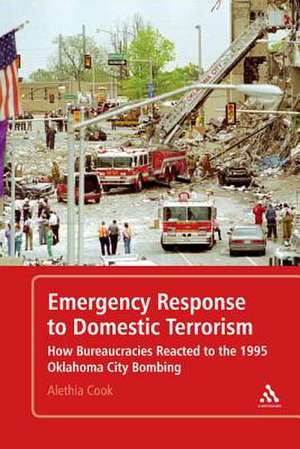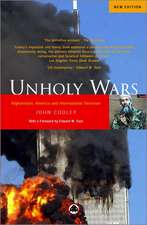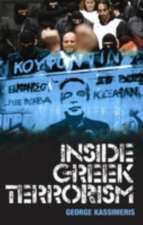Emergency Response to Domestic Terrorism: How Bureaucracies Reacted to the 1995 Oklahoma City Bombing
Autor Dr. Alethia Cooken Limba Engleză Paperback – 31 dec 2009
Emergency Response to Domestic Terrorism analyzes the emergency response to the bombing of the Alfred P. Murrah Federal Building in Oklahoma City on April 19, 1995.
Terrorism is a complex threat, and the American government is expected to deter or intervene in every attack. For that reason, the government must be better prepared to respond to acts of terror. One critical element is to understand what constitutes an "effective response."
To answer this key question, the author examined the existing literature and interviewed thirty-one elite participants in the emergency response to the bombing. The result is a unique qualitative case study that analyzes the response efforts undertaken after the bombing to draw conclusions about their relative success or failure.
Emergency Response to Domestic Terrorism looks at the nature and interrelationship of bureaucratic structures involved in the response, the organizational networking between the response bureaucracy, and the impact of bureaucratic culture on the response.
The work contributes to the existing literatures in both emergency response and bureaucracy. First, theoretical arguments about bureaucracies and their function are put to the test as they are applied to a specific crisis situation. Second, interview materials with key individuals who were on the scene of this American terrorist disaster are provided. Third, the emergency response literature is examined to determine whether the Oklahoma City bombing exhibited the anticipated response challenges. In addition, the work provides insights into the extent to which response communities are familiar with federal response guidelines. The overall results of the study are applicable to emergency response to terrorist incidents and to natural disasters.
By bringing together the academic and the practical aspects of emergency response, the work will appeal to students, practitioners, and policymakers. Further, it will foster better understanding of public policy and public administration in general.
| Toate formatele și edițiile | Preț | Express |
|---|---|---|
| Paperback (1) | 163.24 lei 6-8 săpt. | |
| Bloomsbury Publishing – 31 dec 2009 | 163.24 lei 6-8 săpt. | |
| Hardback (1) | 828.59 lei 6-8 săpt. | |
| Bloomsbury Publishing – 31 dec 2009 | 828.59 lei 6-8 săpt. |
Preț: 163.24 lei
Preț vechi: 190.81 lei
-14% Nou
Puncte Express: 245
Preț estimativ în valută:
31.24€ • 32.71$ • 25.91£
31.24€ • 32.71$ • 25.91£
Carte tipărită la comandă
Livrare economică 09-23 aprilie
Preluare comenzi: 021 569.72.76
Specificații
ISBN-13: 9780826430731
ISBN-10: 0826430732
Pagini: 136
Ilustrații: 5 illus
Dimensiuni: 150 x 224 x 13 mm
Greutate: 0.2 kg
Editura: Bloomsbury Publishing
Colecția Continuum
Locul publicării:New York, United States
ISBN-10: 0826430732
Pagini: 136
Ilustrații: 5 illus
Dimensiuni: 150 x 224 x 13 mm
Greutate: 0.2 kg
Editura: Bloomsbury Publishing
Colecția Continuum
Locul publicării:New York, United States
Caracteristici
The focus on the organisational aspects of the response and the use of expert interviews represent major contributions to an understanding of the bombing and the general challenges faced by first responders.
Cuprins
1. Bureaucratic Response to Disasters: Issues and Methods
Introduces the challenges posed by emergency response and the threat of terrorism, and the difficulties that governments face as they prepare to respond to major disasters.
2. Disaster, Chaos, and Response: First Arrival at the Murrah Building Scence
Describes the response scene in the immediate aftermath of the 1995 bombing. Explains who was doing what from the response community, and the difficulties they encountered.
3. Emergency Response Challenges
Establishes the challenges that past emergency response activities suggested would be encountered persistently during disasters, and how they were actually encountered in the aftermath of the Oklahoma City bombing.
4. Response as a Street-Level Phenomenon
Focuses on the challenges street-level first response bureaucrats face as they attempt to address the implications of a large-scale disaster. Examines the function of bureaucratic structures, the importance of networking to successful response, and the presence of bureaucratic culture and its impact on the response.
5. Response Bureaucracies' Tasks and Goals
Discusses the role FEMA planning guidelines played in the early phases of response to the Oklahoma City bombing. Presents information about the various tasks performed during the response, with a description of the relevant tasks and goals as well as respondents' comments about the success of the actions.
6. Conclusions: Lessons Learned and Reinforced
Appendix A: Interviews Conducted
Appendix B: Interview Questionnaires
Bibliography
Index
Introduces the challenges posed by emergency response and the threat of terrorism, and the difficulties that governments face as they prepare to respond to major disasters.
2. Disaster, Chaos, and Response: First Arrival at the Murrah Building Scence
Describes the response scene in the immediate aftermath of the 1995 bombing. Explains who was doing what from the response community, and the difficulties they encountered.
3. Emergency Response Challenges
Establishes the challenges that past emergency response activities suggested would be encountered persistently during disasters, and how they were actually encountered in the aftermath of the Oklahoma City bombing.
4. Response as a Street-Level Phenomenon
Focuses on the challenges street-level first response bureaucrats face as they attempt to address the implications of a large-scale disaster. Examines the function of bureaucratic structures, the importance of networking to successful response, and the presence of bureaucratic culture and its impact on the response.
5. Response Bureaucracies' Tasks and Goals
Discusses the role FEMA planning guidelines played in the early phases of response to the Oklahoma City bombing. Presents information about the various tasks performed during the response, with a description of the relevant tasks and goals as well as respondents' comments about the success of the actions.
6. Conclusions: Lessons Learned and Reinforced
Appendix A: Interviews Conducted
Appendix B: Interview Questionnaires
Bibliography
Index
Recenzii
"The 1995 Oklahoma City Bombing forced the population in the interior of the United States to recognize that the "heartlands" were not immune from a massive terrorist attack. In the period following the bombing understandable emotion often clouded an objective analysis of how the authorities responded to the tragedy. Alethiia H. Cook has taken advantage of the passage of time to develop an excellent analytical framework and an impressive empirical approach largely based on interviews to provide an important anatomy of the crucial first twelve hours after a major terrorist incident. Emergency Response to Domestic Terrorism : How Bureaucracies Reacted to the 1995 Oklahoma City Bombing should be required reading for policy makers, organizations and operational personnel that are responsible for responding to terrorists attacks and other major catastrophes. It should also be an essential part of any scholar or student who is involved in the increasingly vital and growing field of emergency management" --Stephen Sloan, Lawrence J. Chastang Distinguished Professor of Terrorism Studies,University of Central Florida; Professor Emeritus, The University of Oklahoma












